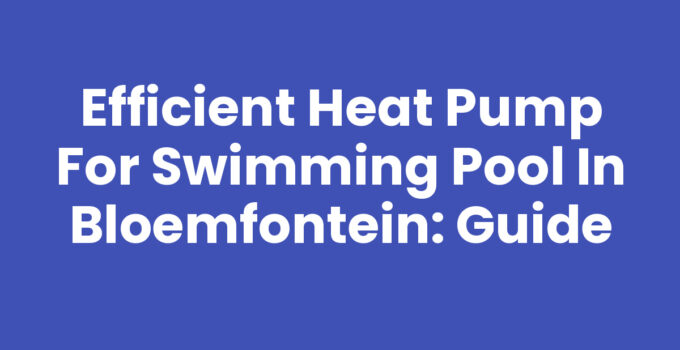Swimming pools are a source of joy and relaxation, especially in a warm city like Bloemfontein. However, maintaining a comfortable water temperature can be challenging without the right equipment. A heat pump specifically designed for swimming pools can be a game changer, extending your swimming season significantly. In this guide, we will explore how a heat pump works, its benefits, and why it is an ideal choice for your swimming pool in Bloemfontein.
Heat Pump for Swimming Pool in Bloemfontein: A Step-by-Step Guide
A heat pump for your swimming pool is an energy-efficient way to provide continuous warmth to the water, making swimming enjoyable, no matter the season. Below is a detailed, step-by-step guide on how to select and install a heat pump for your swimming pool in Bloemfontein.
Step 1: Assess Your Pool Size
Before purchasing a heat pump, determine the total volume of your pool in liters or gallons. This will help you choose a heat pump that has the appropriate capacity. A standard rule of thumb is that a heat pump typically heats 1,000 gallons of water for every 1.5 kW of heating output.
Step 2: Consider the Climate
Bloemfontein enjoys a semi-arid climate, so understanding your local weather patterns can help you make an informed decision. Heat pumps are most efficient when the outside temperature is warm, and they can handle mild winter temperatures effectively. Ensure you choose a heat pump designed to operate optimally in your climate.
Step 3: Choose the Right Type of Heat Pump
There are two main types of heat pumps – air source and ground source. For swimming pools in Bloemfontein, air source heat pumps are typically more cost-effective and easier to install. They extract heat from the air and transfer it to your pool water, providing efficient heating.
Step 4: Installation
Proper installation is crucial for a heat pump to operate efficiently. You can hire a professional to install it following the manufacturer’s guidelines, or consult a local expert in Bloemfontein if you prefer the DIY approach. Make sure the unit is installed in a well-ventilated area, away from obstructions that could hinder airflow.
Step 5: Setting Up the Thermostat
Once installed, set the thermostat to achieve your desired water temperature. It’s generally recommended to maintain a water temperature of around 28-30°C for optimal comfort. Utilize a timer to help manage energy efficiency, allowing you to run the pump when energy rates are lower.
Step 6: Regular Maintenance
To ensure the longevity and performance of your heat pump, perform regular maintenance. This includes cleaning the filters, checking the refrigerant levels, and ensuring that there is no debris obstructing airflow. Regularly maintaining your heat pump will also help to keep energy consumption low and prolong its lifespan.
Benefits of a Heat Pump for Swimming Pools
Investing in a heat pump offers numerous advantages for pool owners in Bloemfontein:
- Energy Efficiency: Heat pumps are more energy-efficient compared to traditional gas or electric heaters, leading to lower utility bills.
- Environmentally Friendly: They minimize energy consumption and reduce your carbon footprint.
- Longer Swimming Season: Enjoy your pool even during cooler months while maintaining a comfortable water temperature.
- Low Operating Costs: With proper setup and management, the operating costs remain relatively low compared to other heating methods.
Important Considerations When Choosing a Heat Pump
When selecting a heat pump for your swimming pool, consider the following factors:
- Size and Capacity: Ensure you choose a pump that matches the size of your pool.
- Energy Source: Choose between air-source or ground-source depending on your budget and installation possibilities.
- Noise Levels: Consider quiet models, especially if you have nearby neighbors.
- Warranty and Support: Look for models that come with a good warranty and easily accessible support services.
In summary, a heat pump for your swimming pool in Bloemfontein offers numerous benefits, from extending your swim season to managing energy efficiency. By following the steps outlined above, you will be well on your way to enjoying the optimal comfort of your swimming pool throughout the year.
Frequently Asked Questions
What is a heat pump, and how does it work?
A heat pump transfers heat from the air to your swimming pool, using electricity to move heat rather than generate it, making it energy-efficient.
Can I install a heat pump myself?
While it's possible to install a heat pump yourself, it's usually recommended to hire a professional for optimal results and adherence to local standards.
How often should I maintain my heat pump?
Regular maintenance is essential; check filters and clean them monthly, and schedule a professional check-up at least once a year.



